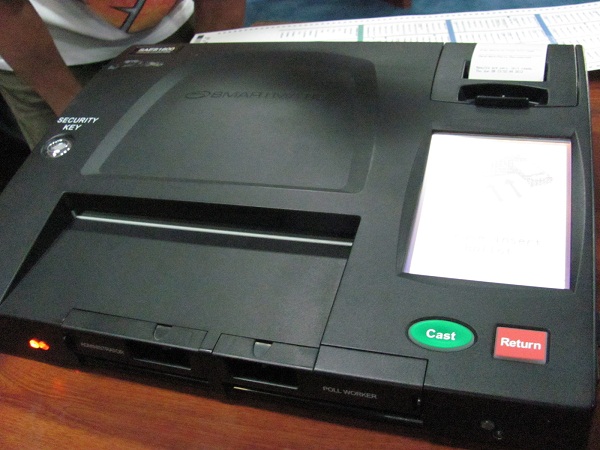It took 41 minutes just to count 20 ballots for national positions during the demonstration of the “taxing, time-consuming and error-prone” hybrid voting system, the Commission on Elections (Comelec) said on Thursday.
The poll body told lawmakers it was no longer inclined to use the hybrid system or the precinct automatic tallying system (Patas) after the June 27 demonstration in Bacoor, Cavite province, revealed serious flaws besides its prohibitive cost.
Presenting the findings to the House suffrage committee, Election Commissioner Christian Robert Lim said the report recommended not to use Patas, which would cost the government some P20 billion, for four reasons:
First, “Patas will cost more than the OMR (optical mark readers) system whether we refurbish or not,” he said.
Second, “Patas will require the amendment of existing laws or the creation of new laws to allow it,” Lim said.
Third, “the Patas’ manual procedure is time-consuming, taxing and prone to human error.”
And fourth, “Patas software still needs to be developed and this will require more than one year,” he added.
Further consultations
Even so, Comelec Chair Andres Bautista said the body was still in the process of consulting other stakeholders before arriving at any decision.
Asked to clarify his statement before the committee, Bautista replied through text: “While the hybrid system has some promising features, it faces cost, logistical and legal challenges that make it not viable for the May 2016 elections.”
Under Patas, the voting and counting will be done manually, while the transmission and canvassing of ballots will be automated.
It is one of the three options the Comelec is considering for the 2016 national polls, the other two being the refurbishment of the 82,000 precinct count optical scan (PCOS, a brand of OMR) machines and the lease of the OMR.
The cost of refurbishing the PCOS machines has been pegged at P2.88 billion, while the lease of OMRs has been estimated at P2.5 billion for 23,000 units, or P7.8 billion for 70,977 units.
Susceptible to human error
Lim identified other problems that cropped up during the Patas demonstration at Bacoor National High School Annex in Cavite on June 27.
He said Patas was susceptible to human error, “since the laptop is operated by a person who might succumb to fatigue or strain his eyes, as the counting progresses.”
Accomplishing the election returns and tally board is time-consuming, he added.
“During counting, it took 41 minutes to count 20 ballots for national positions only,” Lim said.
Four watchers
Candidates would also require a minimum of four watchers to check the accuracy of the count at various stages, from the reading of the votes to the tallying on the laptop computers.
The absence of transparency was also observed during the tallying of votes “since what is seen on the laptop screen is different from what is being projected by the LCD projector,” Lim said.
Patas also opens opportunities to tamper with the ballots because of the procedure in counting the votes, in which votes for President, Vice President and senators are counted first, followed by votes for local candidates, then for party-list groups, he said.
Patas more transparent
But the hybrid system found a defender in Maricor Akol, a convener of the Automated Election System Watch (AES Watch), who said it would still be more transparent than the others.
“It was tedious of course, but we will be able to have more transparency with the manual [component of the] system, and we will know what’s in the election returns,” Akol told the panel.
She said the manual system “can never compare in speed with PCOS,” but she noted the lack of transparency during the times the PCOS machines were used in the 2010 and 2013 elections.
Caloocan Rep. Edgar Erice, a vice chair of the committee, described Patas as “amateurish.”
“They have been talking for more than a year about this system then it turns out to be so problematic. They just wasted our time,” he said.
Escudero
In the upper chamber, Sen. Francis Escudero prefers the Comelec going for full automation, while Sen. Aquilino “Koko” Pimentel III is open to all options, including the hybrid system.
Escudero said he hoped the Comelec would go for the full-automated system instead of adopting a “semi-manual, semi-automated” election.
“I hope the Comelec should decide immediately (on the system of election it would undertake) and I hope its decision was not a backward but a forward push to a clean and faster system. It should not be a system that is slow and could result in cheating,” he said.
Escudero, who heads the Senate committee on finance, said he did not think the poll body had at least P16 billion it needed for the hybrid system unless it went to Congress for an additional budget.
But he said it would be too late for the Comelec to seek an additional budget in September because it must prepare well for any system it would adopt.
For his part, Pimentel urged the Comelec to consider “all possible options, including hybrid, and even theoretically prepare for the worst-case scenario of back to manual elections.”
He noted that the poll body had been stopped in implementing its contract with a company to refurbish its automated machines and that the Comelec was still being subjected to petitions challenging its decisions.–With a report from Christine O. Avendaño
RELATED STORIES
Comelec bucks hybrid poll system; solon calls it ‘palpak’
Comelec: 2016 voting will still be automated
